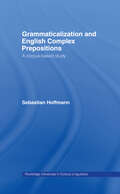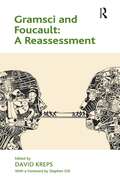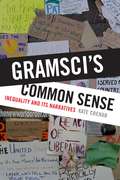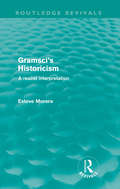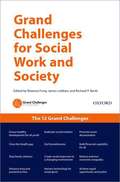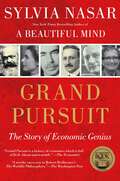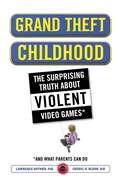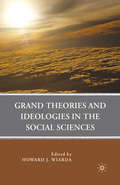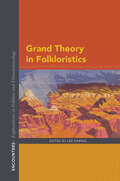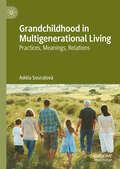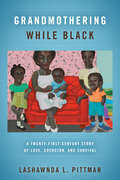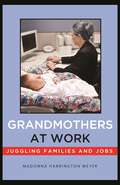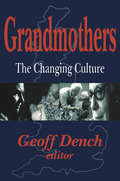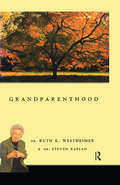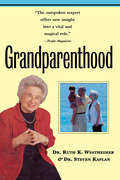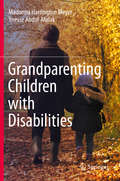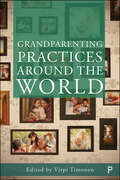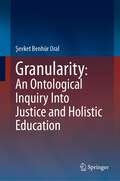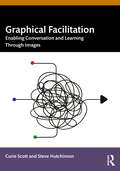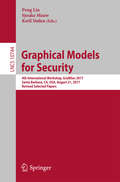- Table View
- List View
Grammar for Teachers: A Guide to American English for Native and Non-Native Speakers (Springer Texts in Education)
by Andrea DeCapuaUpdated and revised with more examples and expanded discussions, this second edition continues the aim of providing teachers with a solid understanding of the use and function of grammatical structures in American English. The book avoids jargon and presents essential grammatical structures clearly and concisely. Dr. DeCapua approaches grammar from a descriptive rather than a prescriptive standpoint, discussing differences between formal and informal language, and spoken and written English. The text draws examples from a wide variety of authentic materials to illustrate grammatical concepts. The many activities throughout the book engage users in exploring the different elements of grammar and in considering how these elements work together to form meaning. Users are encouraged to tap into their own, often subconscious, knowledge of grammar to consciously apply their knowledge to their own varied teaching settings. The text also emphasizes the importance of understanding grammar from the perspective of English language learners, an approach that allows teachers to better appreciate the difficulties these learners face. Specific areas of difficulties for learners of English are highlighted throughout.
Grammaticalization and English Complex Prepositions: A Corpus-based Study (Routledge Advances in Corpus Linguistics #Vol. 7)
by Sebastian HoffmannWhat is a grammatical unit? How does grammatical structure evolve? How can we best investigate the mental representation of grammar? What is the connection between language use and language structure? This book aims to help answer such questions by presenting a detailed analysis of English complex prepositions (e.g. in spite of or with respect to) on the basis of large amounts of authentic language data dating from the Middle Ages until today.
Gramsanskruti: ग्रामसंस्कृती
by Anand Yadavस्वातंत्र्योत्तर काळातील पन्नास वर्षांत ग्रामजीवन आणि ग्रामसंस्कृती यांच्यात मूलगामी स्थित्यंतरे झाली. त्यांतून स्वातंत्र्यपूर्वकाळातील खेडे जवळजवळ नष्ट झाले. त्याचे फार थोडे अवशेष महाराष्ट्राच्या पार आंतरिक भागात, डोंगरकपारींच्या आदिवासी मुलखात शिल्लक राहिले. महाराष्ट्राच्या या बदलत्या खेड्याचे एकूणच सामाजिक, आर्थिक, शैक्षणिक, प्राकृतिक, सांस्कृतिक अंतरंग प्रस्तुत ग्रंथात उकलून दाखविण्याचा आनंद यादवांनी प्रयत्न केला आहे. आनंद यादव या नवयुगसदृश स्थित्यंतराचे प्रत्यक्ष साक्षी आहेत. त्यांनी महाराष्ट्राचे बदलते खेडे प्रत्यक्ष अनुभवल्याचा प्रत्यय या ग्रंथात पानोपानी येतो. मराठी विचारवंत, सुधारक, साहित्यिक, प्राध्यापक, कार्यकर्ते, संस्कृतिउपासक, चळवळकर्ती तरुण पिढी, सामाजिक शास्त्रांचे अभ्यासक आणि जाणकार वाचक या सर्वांनाच मार्गदर्शक व प्रेरक ठरेल अशा योग्यतेचा हा पहिलाच मराठी ग्रंथ आहे.
Gramsci and Foucault: A Reassessment
by David KrepsMapping the resonances, dissonances, and linkages between the thought of Gramsci and Foucault to uncover new tools for socio-political and critical analysis for the twenty-first century, this book reassesses the widely-held view that their work is incompatible. With discussions of Latin American revolutionary politics, indigenous knowledges, technologies of government and the teaching of paediatrics in post-invasion Iraq, complexity theory, medical anthropology and biomedicine, and the role of Islam in the transition to modern society in the Arab world, this interdisciplinary volume presents the latest theoretical research on different facets of these two thinkers’ work, as well as analyses of the specific linkages that exist between them in concrete settings. A rigorous, comparative exploration of the work of two towering figures of the twenty-first century, Gramsci and Foucault: A Reassessment will appeal to scholars and students of social and political theory, political sociology, communication and media studies, and contemporary philosophy.
Gramsci's Common Sense: Inequality and Its Narratives
by Kate CrehanAcknowledged as one of the classics of twentieth-century Marxism, Antonio Gramsci's Prison Notebooks contains a rich and nuanced theorization of class that provides insights that extend far beyond economic inequality. In Gramsci's Common Sense Kate Crehan offers new ways to understand the many forms that structural inequality can take, including in regards to race, gender, sexual orientation, and religion. Presupposing no previous knowledge of Gramsci on the part of the reader, she introduces the Prison Notebooks and provides an overview of Gramsci's notions of subalternity, intellectuals, and common sense, putting them in relation to the work of thinkers such as Bourdieu, Arendt, Spivak, and Said. In the case studies of the Tea Party and Occupy Wall Street movements Crehan theorizes the complex relationships between the experience of inequality, exploitation, and oppression as well as the construction of political narratives. Gramsci's Common Sense is an accessible and concise introduction to a key Marxist thinker whose works illuminate the increasing inequality in the twenty-first century.
Gramsci's Historicism: A Realist Interpretation
by Esteve MoreraFirst published in 1990, this book is a comprehensive study of Gramsci's Quaderni, and gives the reader a penetrating account of the structure of Gramsci's thought. The author draw on many materials and sources, making accesible to the English-speaking reader a wide range of texts otherwise only available in Italian, French, Spanish, and Catalan. His book sheds light on Gramsci's basic philosophical and methodological principles, and will be useful as an introduction to Gramsci for students of political science, sociology, social science, history, and philosophy, as well as to scholars in the field.
Grand Challenges for Social Work and Society
by Rowena Fong Richard P. Barth James LubbenThe Grand Challenges for Social Work Initiative (GCSWI), which is spearheaded by the American Academy of Social Work and Social Welfare (AASWSW), represents a major endeavor for the entire field of social work. GCSWI calls for bold innovation and collective action powered by proven and evolving scientific interventions to address critical social issues facing society. The purpose of GCSWI was modeled after the National Academy of Engineering, which aimed to identify some of the most persistent engineering problems of the day and then put the attentions, energies, and funding of the entire field to work on them for a decade. The GCSWI does the same for social issues, tackling problems such as homelessness, social isolation, mass incarceration, family violence, and economic inequality. Grand Challenges for Social Work and Society is an edited book that will present the foundations of the GCSWI, laying out the start of the initiative and providing summaries of each of the twelve challenges. The 12 main chapters that form the core of the book, one on each of the dozen Grand Challenges, are written by the primary research teams who are driving each GC project.
Grand Designs: Consumer Markets and Home-Making
by Aneta Podkalicka Esther Milne Jenny KennedyThis is the first academic book to examine the long running hit series Grand Designs, which occupies a significant place in the popular imagination internationally. The authors apply an empirically grounded, critical perspective to the study of television to reveal how people use the program in their everyday lives. The emphasis on everyday uses and meanings combines creatively with understanding the program theoretically, textually and in terms of its production structures. This position challenges framings of the popular lifestyle and factual television genre that has been dominated by a neoliberal or governmentality perspective for many years. Presented by British designer and writer, Kevin McCloud, Grand Designs follows the progress of home owners as they embark on design, renovation and building projects at almost always dizzying scales of endeavour. Understanding the program as both a text to analyse and a site of material impact, the book draws on interviews with production members, home renovators, building practitioners and audiences, as well as references to associated media formats to provide contextual depth to the analysis. The authors argue that, as a cultural object, the program is both shaped by and enacts social discourses of home-making, design value and taste. Navigating public, commercial and promotional logics, Grand Designs sparks new forms of cultural production and consumer markets.
Grand Pursuit: The Story of Economic Genius
by Sylvia NasarIn a sweeping narrative, the author of the megabestseller A Beautiful Mind takes us on a journey through modern history with the men and women who changed the lives of every single person on the planet. It’s the epic story of the making of modern economics, and of how economics rescued mankind from squalor and deprivation by placing its material fate in its own hands rather than in Fate. Nasar’s account begins with Charles Dickens and Henry Mayhew observing and publishing the condition of the poor majority in mid-nineteenth-century London, the richest and most glittering place in the world. This was a new pursuit. She describes the often heroic efforts of Marx, Engels, Alfred Marshall, Beatrice and Sydney Webb, and the American Irving Fisher to put those insights into action—with revolutionary consequences for the world. From the great John Maynard Keynes to Schumpeter, Hayek, Keynes’s disciple Joan Robinson, the influential American economists Paul Samuelson and Milton Freedman, and India’s Nobel Prize winner Amartya Sen, she shows how the insights of these activist thinkers transformed the world—from one city, London, to the developed nations in Europe and America, and now to the entire planet. In Nasar’s dramatic narrative of these discoverers we witness men and women responding to personal crises, world wars, revolutions, economic upheavals, and each other’s ideas to turn back Malthus and transform the dismal science into a triumph over mankind’s hitherto age-old destiny of misery and early death. This idea, unimaginable less than 200 years ago, is a story of trial and error, but ultimately transcendent, as it is rendered here in a stunning and moving narrative.
Grand Theft Childhood: The Surprising Truth About Violent Video Games and What Parents Can Do
by Lawrence Kutner Cheryl OlsonListening to pundits and politicians, you'd think that the relationship between violent video games and aggressive behavior in children is clear. Children who play violent video games are more likely to be socially isolated and have poor interpersonal skills. Violent games can trigger real-world violence. The best way to protect our kids is to keep them away from games such as Grand Theft Auto that are rated M for Mature. Right? Wrong. In fact, many parents are worried about the wrong things! In 2004, Lawrence Kutner, PhD, and Cheryl K. Olson, ScD, cofounders and directors of the Harvard Medical School Center for Mental Health and Media, began a $1.5 million federally funded study on the effects of video games. In contrast to previous research, their study focused on real children and families in real situations. What they found surprised, encouraged and sometimes disturbed them: their findings conform to the views of neither the alarmists nor the video game industry boosters. In Grand Theft Childhood: The Surprising Truth about Violent Video Games and What Parents Can Do, Kutner and Olson untangle the web of politics, marketing, advocacy and flawed or misconstrued studies that until now have shaped parents' concerns. Instead of offering a one-size-fits-all prescription, Grand Theft Childhood gives the information you need to decide how you want to handle this sensitive issue in your own family. You'll learn when -- and what kinds of -- video games can be harmful, when they can serve as important social or learning tools and how to create and enforce game-playing rules in your household. You'll find out what's really in the games your children play and when to worry about your children playing with strangers on the Internet. You'll understand how games are rated, how to make best use of ratings and the potentially important information that ratings don't provide. Grand Theft Childhood takes video games out of the political and media arenas, and puts parents back in control. It should be required reading for all families who use game consoles or computers. Almost all children today play video or computer games. Half of twelve-year-olds regularly play violent, Mature-rated games. And parents are worried... "I don't know if it's an addiction, but my son is just glued to it. It's the same with my daughter with her computer...and I can't be watching both of them all the time, to see if they're talking to strangers or if someone is getting killed in the other room on the PlayStation. It's just nerve-racking!" "I'm concerned that this game playing is just the kid and the TV screen...how is this going to affect his social skills?" "I'm not concerned about the violence; I'm concerned about the way they portray the violence. It's not accidental; it's intentional. They're just out to kill people in some of these games." What should we as parents, teachers and public policy makers be concerned about? The real risks are subtle and aren't just about gore or sex. Video games don't affect all children in the same way; some children are at significantly greater risk. (You may be surprised to learn which ones!) Grand Theft Childhood gives parents practical, research-based advice on ways to limit many of those risks. It also shows how video games -- even violent games -- can benefit children and families in unexpected ways. In this groundbreaking and timely book, Drs. Lawrence Kutner and Cheryl Olson cut through the myths and hysteria, and reveal the surprising truth about kids and violent games.
Grand Theories and Ideologies in the Social Sciences
by Howard J. WiardaThis book analyzes the main competing grand theories in the social sciences, including developmentalism, dependency analysis, Marxism, institutionalism, rational choice, Freudianism, environmentalism, sociobiology, neurosciences, and transitions to democracy.
Grand Theory in Folkloristics (Encounters: Explorations in Folklore and Ethnomusicology)
by Lee HaringEssays arguing diverse positions on the concept of a grand theory in American folklore.Why is there no “Grand Theory” in the study of folklore? Talcott Parsons (1902–1979) advocated “grand theory,” which put the analysis of social phenomena on a new track in the broadest possible terms. Not all sociologists or folklorists accept those broad terms; some still adhere to the empirical level. Through a forum sponsored by the American Folklore Society, the diverse answers to the question of such a theory arrived at substantial agreement: American folklorists have produced little “grand theory.” One speaker even found all the theory folklorists need in the history of philosophy. The two women in the forum (Noyes and Mills) spoke in defense of theory that is local, “apt,” suited to the audience, and “humble”; the men (Bauman and Fine) reached for something Parsons might have recognized. The essays in this collection, developed from the forum presentations, defend diverse positions, but they largely accept the longstanding concentration in American folkloristics on the quotidian and local.
Grandchildhood in Multigenerational Living: Practices, Meanings, Relations
by Adéla SouralováGrandchildhood in Multigenerational Living: Practices, Meanings, Relations is the first book to sociologically analyse grandchild-grandparent relationships from the perspective of grandchildren. Expanding the knowledge about hitherto under-researched grandchildren, this book puts grandchildren’s perspectives in the centre of qualitative analysis focuses. Presenting grandchildhood in its complexity, the author addresses its multiple dimensions from 54 in-depth interviews with grandchildren living in three-generation households with their parents and grandparents. Drawing upon 'family practices', this book conceptionally develops ‘grandchild practices’ as a new approach to see the diversities and similarities, harmonies and tensions, joys and obligations, or, simply put, the daily ambivalences of family relationships. This unique book is an indispensable resource for researchers and students of family studies and sociology of generations who wish to investigate how grandchildren understand, negotiate and make sense of their relationships with grandparents.
Grandmothering While Black: A Twenty-First-Century Story of Love, Coercion, and Survival
by LaShawnDa L. PittmanIn Grandmothering While Black, sociologist LaShawnDa L. Pittman explores the complex lives of Black grandmothers raising their grandchildren in skipped-generation households (consisting only of grandparents and grandchildren). She prioritizes the voices of Black grandmothers through in-depth interviews and ethnographic research at various sites—doctor's visits, welfare offices, school and day care center appointments, caseworker meetings, and more. Through careful examination, she explores the various forces that compel, constrain, and support Black grandmothers' caregiving. Pittman showcases a fundamental change in the relationship between grandmother and grandchild as grandmothers confront the paradox of fulfilling the social and legal functions of motherhood without the legal rights of the role. Grandmothering While Black illuminates the strategies used by grandmothers to manage their legal marginalization vis-à-vis parents and the state across a range of caregiving arrangements. In doing so, it reveals the overwhelming and painful decisions Black grandmothers must make to ensure the safety and well-being of the next generation.
Grandmothers at Work: Juggling Families and Jobs
by Madonna Harrington MeyerA study of the lived experience of working grandmothers in early twenty-first–century America.Young working mothers are not the only ones who are struggling to balance family life and careers. Many middle-aged American women face this dilemma as they provide routine childcare for their grandchildren while pursuing careers and trying to make ends meet. Madonna Harrington Meyer’s Grandmothers at Work explores the lived experience of working grandmothers. While all of the grandmothers in the book are pleased to spend time with their grandchildren, many are readjusting work schedules, using vacation and sick leave time, gutting retirement accounts, and postponing retirement to care for grandchildren. Some simply want to do this; others do so because their adult children need assistance and may have less security and flexibility on the job than do their mothers. Most of the grandmothers expect to continue feeling the pinch of paid and unpaid work for many years before their retirement. Grandmothers at Work provides a unique perspective on a phenomenon faced by millions of women in America today.Winner of the 2014 Richard Kalish Innovative Publication Award presented by the Gerontological Society of America
Grandmothers: The Changing Culture
by Geoff DenchOver the past few years there has been a surge of interest in Britain on grandparenting - although it is still a long way behind the USA and several European countries in research in the area. The driving impetus for research is coming from parenting organizations and government departments concerned about the effects on female employment of shortages in nursery places, and about the effect of "parenting deficits" on children. Greater involvement of grandmothers in caring for children has seemed to offer a solution to many related problems. It promises to improve care within the family, and enable mothers to take on paid work with fewer fears for the consequences, without removing other working adults in the family from their jobs. This text discusses how today's grandmothers are changing the image and role that they filled in the past.
Grandparenthood (Senior Lifestyles Ser.)
by Dr. Ruth Westheimer Dr. Steven KaplanFirst published in 1998. Routledge is an imprint of Taylor & Francis, an informa company.
Grandparenthood (Senior Lifestyles Ser.)
by Dr. Ruth Westheimer Dr. Steven KaplanThis book provides a capsule description of what is known today about the particular aspect of grandparenting, whether it's gift-giving, adoption, travel, or discipline. It presents a picture of the current state of knowledge on grandparenting and the grandparent's place in the family.
Grandparenting Children with Disabilities (Social Indicators Research Ser. #66)
by Madonna Harrington Meyer Ynesse Abdul-MalakChildhood disabilities, particularly cognitive disabilities, are on the rise yet social programs and services to help US families respond to disabilities are not. Many families turn to grandparents for assistance juggling work, family responsibilities, and specialized therapies. This book is based on in-depth interviews with grandparents who are providing at least some care to grandchildren with disabilities. The analyses will help to better understand (1) under what conditions grandparents provide care and support, (2) what types and intensities of care and support grandparents provide, and (3) the impact of that care and support on grandparents’ social, emotional, physical, and financial wellbeing. In this fascinating and provocative book, Madonna Harrington Meyer and Ynesse Abdul-Malak take readers on a deep dive into the complex lives of grandparents who care for their disabled grandchildren. In Grandparenting Children with Disabilities, their interviews reveal the joy, meaning, and purpose grandparents find in caregiving, the challenges and frustrations they encounter, and the many ways they compromise their own health and well-being for the sake of their grandchildren. Drawing from theories of cumulative inequality and from their deep knowledge of the US policy context, the authors lay bare the systemic failures that leave families of children with disabilities without adequate support and that place the most vulnerable among them at grave physical, emotional, and financial risk…Jane McLeod, Provost Professor, Indiana University Grandparents in the U.S. already take on far more parenting responsibilities as compared to their peers in other countries. Grandparenting Children with Disabilities demonstrates that the intensity of these responsibilities is compounded for those whose grandchildren have disabilities given limited policy supports and a society still largely unaccommodating to those with disabilities. This book beautifully navigates the tension between the love these grandparents have for their grandchildren and the challenges they face caring for them.Pamela Herd, Professor, Georgetown University Grandparenting Children with Disabilities offers important insights about the lived experience of older adults who care for and care about their grandchildren…The authors skillfully integrate the stories they tell with consideration of macro social structural influences and life course perspectives… I recommend it highly!Eva Kahana, Distinguished University Professor, Case Western Reserve
Grandparenting Practices Around the World: Reshaping family
by Virpi TimonenThis exciting collection presents an in-depth, up-to-date analysis of the unprecedented phenomenon of increasing numbers of grandparents worldwide, co-existing and interacting for longer periods of time with their grandchildren. The book contains analyses of topics that have so far received relatively little attention, such as transnational grandparenting and gender differences in grandparenting practices. It is the only collection that brings together theory-driven research on grandparenting from a wide variety of cultural and welfare state contexts - including chapters on Europe, North America, Africa, Asia and Australia - drawing broad lines of debate rather than focusing at a country level. Building on the success of ‘Contemporary grandparenting’, edited by Virpi Timonen and Sarah Arber, this book further deepens our understanding of how social structures continue to shape grandparenting across a wide range of cultural and economic contexts. The book is essential reading and reference for researchers, students and policy-makers who want to understand the growing influence of grandparents in ageing families and societies across the world.
Grandparents/Grandchildren: The Vital Connection
by Kenneth L. Woodward Arthur KornhaberIn this book Kornhaber and Woodward explore the vital connections which link generations to each other and expose a new social contract that destroys the emotional bonds between grandparents and grandchildren., This is the first book which reviews, in a careful ethnographic manner, the relationship of grandchildren to grandparents and the place of love at one end and abandonment at the other by grandparents. The authors probe the deep, unexplored emotional histories of hundreds of grandparents; how they feel about themselves, their grandchildren, and their loss of function within today's nuclear family., With sharp increases in the number of broken families and working mothers, grandparents are more vital than ever and also more available than ever. This basic research document shows how grandparents recover their natural role as elders of the family and of society. The author's basic premise is that to exist is to be connected, and that no matter how grandparents act, they affect the emotional well-being of their grandchildren, for better or for worse, simply because they exist., In an age when mounting economic and social pressures make it increasingly easier to split a family than to sustain one, the authors alert us to a forgotten source of family strength, the power of grandparents to enrich the lives as a whole. The case studies reported in this volume represent a first effort in an area left unexplored by developmental researchers. There are lessons here for social scientists, but even more for our alienated society.—Urie Bronfenbrenner, Cornell University
Granularity: An Ontological Inquiry Into Justice and Holistic Education
by Şevket Benhür OralThis book presents an original exploration of philosophical questions pertaining to the ways we grasp the Absolute by bringing together the Buddhist notion of interpermeation of all phenomena into contemporary strains of thought in continental philosophy. This text introduces an ontological concept, granularity, deploying it to probe questions concerning the intersection of ontology, ethics, and education. A wide range of issues in metaphysics are covered—including being, nothingness, unity, plurality, truth, change, transformation, subjectivity, contradiction, coherence, potentiality—from the perspective of thinkers such as Hegel, Heidegger, Badiou, Meillassoux, Malabou, Žižek, and Harman. The text deploys granularity in arguing for an ethics of unconditional hospitality within education. This volume is intended for students and researchers working in the areas of philosophy of education, philosophy of religion, and continental philosophy.
Graphic Girlhoods: Visualizing Education and Violence (Children's Literature And Culture Ser.)
by Elizabeth MarshallDrawing on a dynamic set of "graphic texts of girlhood," Elizabeth Marshall identifies the locations, cultural practices, and representational strategies through which schoolgirls experience real and metaphorical violence. How is the schoolgirl made legible through violence in graphic texts of girlhood? What knowledge about girlhood and violence are under erasure within mainstream images and scripts about the schoolgirl? In what ways has the schoolgirl been pictured in graphic narratives to communicate feminist knowledge, represent trauma, and/or testify about social violence? Graphic Girlhoods focuses on these questions to make visible and ultimately question how sexism, racism and other forms of structural violence inform education and girlhood. From picture books about mean girls The Recess Queen or graphic novels like Jane, The Fox and Me to Ronald Searle's ghastly pupils in the St. Trinian's cartoons to graphic memoirs about schooling by adult women, such as Ruby Bridges's Through My Eyes and Lynda Barry's One Hundred Demons texts for and about the schoolgirl stake a claim in ongoing debates about gender and education.
Graphical Facilitation: Enabling Conversation And Learning Through Images
by Steve Hutchinson Curie ScottIf ‘a picture is worth a thousand words,’ this book provides an approach to help create professional pictures that productively and powerfully capture conversations and thinking for individual and collective learning. Individuals are bombarded by information, and organizations, managers, and teachers often lack a corresponding set of tools to make sense of this complexity—resulting in far too many “death by bullet-point” presentations. This is that toolkit, also offering invitations to readers to extend their thinking past these tools to enable the creation (and co-creation with teams, learners, and clients) of graphical depictions, models, and metaphors to help people make sense of their world. This accessible book is constructed as a visual reference so readers can quickly pick out the specific tool or strategy they need, whether working with individuals and teams to promote self-awareness, develop emotional intelligence, improve communication, or articulate vision and strategy.This clear and adaptable guide will be a welcome resource for teachers, trainers, managers, and coaches to empower people to learn, think, and create in a powerful, memorable, and graphical way.
Graphical Models for Security: Second International Workshop, Gramsec 2015, Verona, Italy, July 13, 2015, Revised Selected Papers (Lecture Notes in Computer Science #9390)
by Sjouke Mauw Peng Liu Ketil StolenThis book constitutes revised selected papers from the 4th International Workshop on Graphical Models for Security, GraMSec 2017, held in Santa Barbara, CA, USA, in August 2017. The 5 full and 4 short papers presented in this volume were carefully reviewed and selected from 19 submissions. The book also contains one invited paper from the WISER project. The contributions deal with the latest research and developments on graphical models for security.

